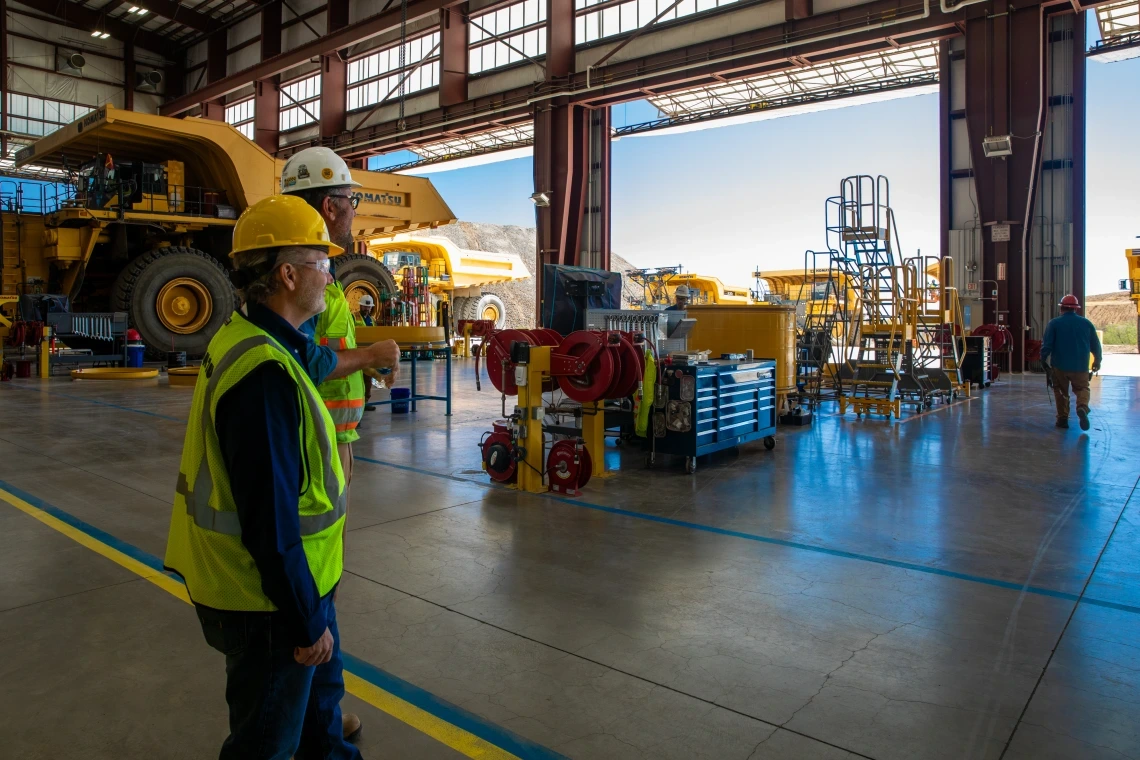Industry partner credits university with fostering mining innovation

Komatsu experts Mark Schaeffer, vice president for strategy (left), and Neil Johnson, test development manager (right) in the Komatsu Arizona Proving Grounds workshop near Tucson, Arizona. Leslie Hawthorne Klingler photo.
Mark Schaeffer, vice president for strategy at Komatsu Mining Technology Solutions in Tucson, thinks he's found his sweet spot in an industry often dismissed: mining.
"There's no getting around it – mining contributes to society in a big way," he said.
Schaeffer said everything that makes modern life possible relies on just two foundational industries: agriculture and mining.
"Without them, we'd still be living as small hunter-gatherer groups. Most of us wouldn't choose that life," he said. "But we often choose to ignore where our conveniences come from."
He doesn't mince words describing the environmental challenges mining presents.
"The thing is, these are solvable problems that we must solve because we need minerals," he said.
Tucson: 'A U.S. hub for mining technology'
Schaeffer insists on increased collaboration across companies and sectors. Komatsu is ahead of the curve, he said.
"We collaborate with customers and even competitors to find better solutions."
Game-changing collaborations have already happened in the desert Southwest. He calls Tucson "a U.S. hub for mining technology," with the presence of heavyweights Komatsu, Caterpillar, Freeport, and BHP, as well as the University of Arizona and numerous industries ancillary to mining.
"Once you get enough people in the same area, it creates its own ecosystem of innovation."
Schaeffer credits the University of Arizona with greatly enriching the mining innovation ecosystem when, in the late 1970s, university researchers developed ideas to use computer programming to improve the coordination and maneuvering of haul trucks in mines. In a large mine, more than 100 trucks can operate simultaneously.
James White, an associate professor of chemical engineering, founded Modular Mining with a small team that included Juan (John) Reza and Mark Baker in 1979.
Modular Mining developed the world's first computerized fleet management system, called DISPATCH®, which used real-time data to optimize truck assignments, reduce idle time and increase productivity. This was a revolutionary advancement in mining operations and set the foundation for the modern mine management systems in use today. Komatsu acquired the company in 1996 as part of developing autonomous haul trucks.
"Fleet management for the entire mining world started in Tucson," said Schaeffer. "A few years later, a group here, together with a group in Japan, created the first autonomous trucks. By 2008, Komatsu had autonomous trucks running 24/7."
Schaeffer wants Tucson to be recognized as a global center for mining innovation.
"If everyone steps up our game, we're positioned to join Brisbane, Australia, and Santiago, Chile, as a globally admired incubator for startups," he said, adding that Komatsu now runs a program to help small companies access data they need to build and test new mining products.
An opportunity for success
Schaeffer said young people who choose a career in mining will be rewarded with well-compensated, stable and fulfilling work.
"It's a big industry in terms of dollars and scope, but it's a relatively small world in terms of workers and the number of relevant mining sites. In the course of their career, an individual can become well-known throughout the industry. And that can be extremely rewarding."
